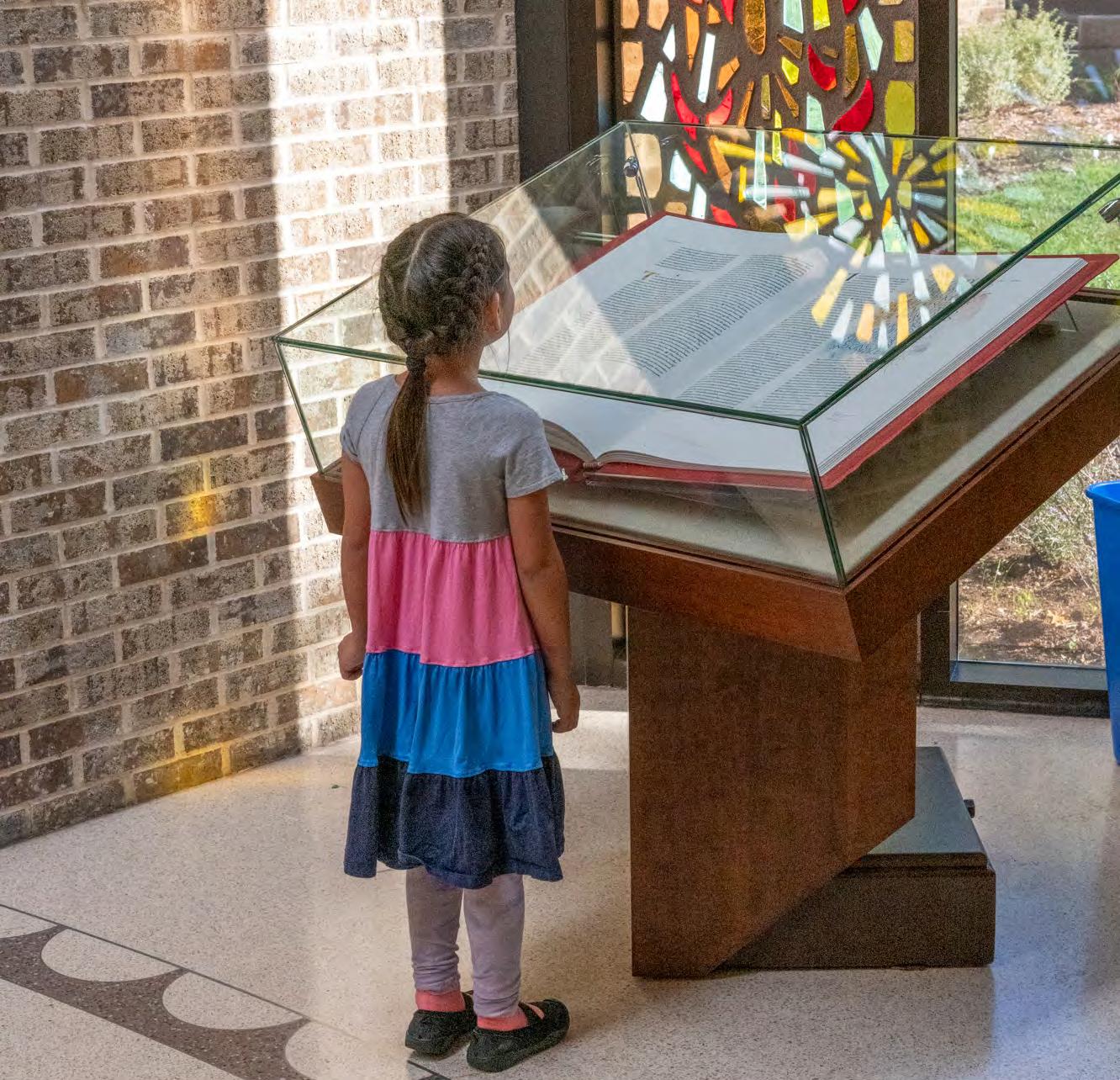ILLUMINE
enlightening and celebrating where God is at work in our midst WINTER 2024





enlightening and celebrating where God is at work in our midst WINTER 2024




Iwant to tell you the story of my baptism. We are taught as Christians that the day we are baptized is one of, if not the , most important of our lives. This is certainly the case for me, though I have no memory of it.
Although I’ve lived here most of my life, I am not, strictly speaking, a native Texan. I was born in Richmond, Virginia, where my family lived until I turned six. My mother is a native Texan, however, and her family has lived in central Texas for four generations. So, for my very first Christmas, my parents made the long drive from Richmond to Belton to spend it with my maternal family. I was five months old, and I had not yet been baptized.
Not long before, my parents had begun attending a small Episcopal mission church in our neighborhood. Neither of my parents were Episcopalian; my mother had been raised in the Church of Christ, and my father grew up Presbyterian. The Episcopal Church was brand new for them, but they liked it.
And so, as they prepared to make that Christmas trip to Texas, my mother decided to reach out to an Episcopal parish in Temple, Christ Church, to see if it might be possible for me to be baptized while they were in town. Now, I know how I would likely reply to such a request made just weeks before Christmas, and yet the rector said he would be perfectly happy to baptize me. “How about you come in on December 23, and we can do it then,” he said to my parents.
The rector’s name was Joe di Paola, and he figures quite prominently in the story of my life. To this day, I am amazed by his response to my parents’ request. We were total strangers to him and barely Episcopalians. Sightunseen, with no hurdles to jump, classes to attend, or proofs to give, he invited us to come in the day before Christmas Eve ! I know quite well how many things were rattling around in his mind and the length of his to-do list. We were not even prospective members, as we would drive back to Virginia a week later. And yet, Fr. Joe poured grace upon our family, even before he poured the grace of baptismal water upon my head.
Grace has a way of changing lives. We say that as Christians, and I am living proof.
A few years later, we moved to Temple, and you can guess where we went to church. No, it’s not enough to say we “went to church.” Christ Church became our second home. My mother joined the altar guild, my father was elected to the vestry, I became an acolyte, and we were all in. We learned how to be followers of Jesus in that church. It’s where I was confirmed. They sponsored me for ordination. I even worked there for a short time before heading to seminary. My parents are still active, and it is a rare week that they aren’t at church less than twice. And it all comes back to Fr. Joe and his decision to practice grace.
On a small table in my office sits an icon of Christ the Teacher that is priceless to me. When I look upon it, Christ peers into my soul and calls me to follow him. He offers me grace and asks me to bear that grace to others. I suppose any icon of Christ could do that, but this one has special power for me. You see, I inherited this icon of Christ the Teacher from the man who first taught me the grace-filled ways of Christ, Fr. Joe.
I think about Fr. Joe whenever the ways of the world tempt me to become rigid and cynical. I’ll be faced with a situation and wonder if the person “deserves” my time, my attention, my forgiveness. But for the Christian, “deserve” is a dangerous word, and if that is the primary category by which we make decisions and live our lives, we will struggle to know the joy of God’s kingdom. Listen to Jesus in the Gospel of Luke:
“Ask yourself what you want people to do for you; then grab the initiative and do it for them! If you only love the lovable, do you expect a pat on the back? Run-of-the-mill sinners do that. If you only help those who help you, do you expect a medal? Garden-variety sinners do that. If you only give for what you hope to get out of it, do you think that’s charity? The stingiest of pawnbrokers does that…Live out this God-created identity the way our Father lives toward us, generously and graciously (6:31-36, The Message ).”

Some of you know of my custom of reading
A Christmas Carol in Advent every year. I have my friend Roy Heller to thank for this tradition, which blesses me afresh with every reading. One of the things I love about A Christmas Carol is the way different characters pop out at me at different times. Marley’s ghost is always striking, and who doesn’t love old Fezziwig? But this year, Ebenezer Scrooge’s nephew, Fred, is the character I’ve been sitting with most.
More than anyone else in the whole story, Fred embodies grace. Every year, he visits his uncle and invites him to dinner on Christmas, despite knowing how Scrooge will reply. “I want nothing from you; I ask nothing of you,” Fred pleads, all but begging the hard-hearted miser to receive the gift he longs to give. And when Scrooge is led by the Ghost of Christmas Present to the very party he rejected, he is able to hear his nephew toast him without any guile or sarcasm. He has chosen to love his decidedly difficult-to-love uncle, and that grace is like breath on the tiny ember of warmth still in Scrooge’s heart.
Grace has a way of changing lives.
The world constantly bombards us with its so-called wisdom: might makes right; more is always better; you get what you deserve. But we proclaim a different message, an alternative way, and it is rooted in grace. The ways of the world only ever seem to beget more of the same: more greed, more violence, more loneliness. But the way of grace begets more grace. When we put undeserved kindness and love into the world, it moves outward like a ripple on a pond, swelling up and over countless others with the kingdom of God. Our little yes, our small sacrifice for someone else, our disregard of “deserve” to live more like our Lord…it can literally change a life. I am living proof.

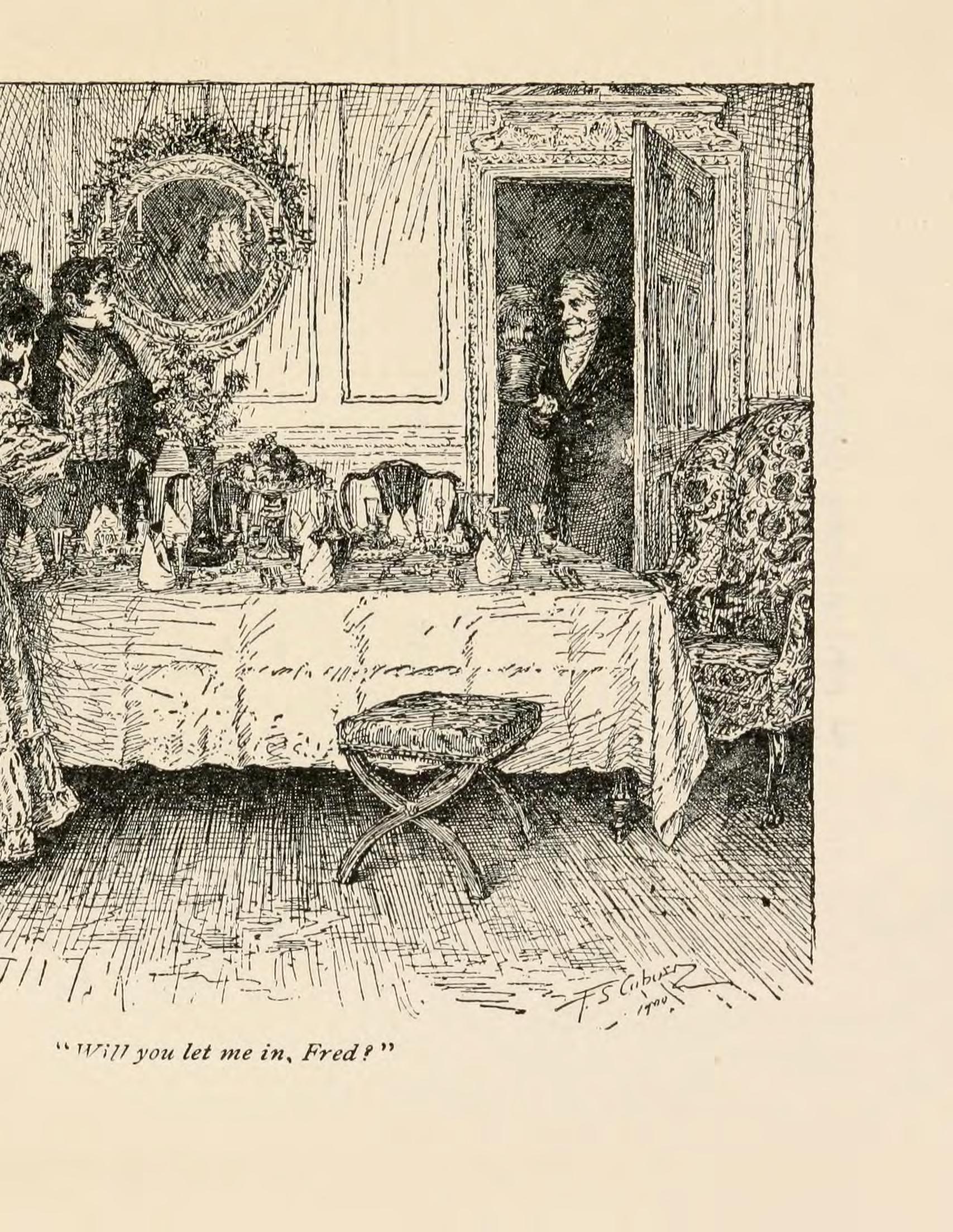

by Chris Kelley and the Rev. Casey Shobe
“Out of Zion, the perfection of beauty, God shines forth.”— Psalm 50:2
She awaits us, outside of clock time, to arrest us. Like a hidden detective, she seizes our every perception, collapsing our thoughts, feelings, and sensations before transporting us to a sacred space that suspends – if for only a moment – reality.
Beauty is her name. And, we yearn for her.
And, we yearn more every day as our object and experienceobsessed society, much of it artificial, continues to crank out the mass-produced that is vacant and without the sensibility of beauty. Beauty is not simply a neutral alteration of waking consciousness; it is a rendezvous with our deepest nature. This is why we long for it, precisely because it is mostly veiled by the assumptions of our “modern” society.
For centuries, Anglicans have emphasized beauty in worship, through poetic prayers, dignified architecture, beautiful music, and visual art. These aesthetic experiences serve as a pathway to connect with the divine and express the richness of Christian truth. “Beauty is a reflection of God’s nature, so when we experience beauty, we are drawn closer to God,” our rector, the Rev. Casey Shobe, says.
Transfiguration has long celebrated beauty, led by its past rectors, the Revs. Terence Roper and J.D. Godwin. The triptych of the Transfigured Christ was commissioned in the 1980s and provides a gorgeous devotional focus for the Nave. The altar was created in the 1990s as its stunning pair. Similarly, sculptures have been cast, windows created, a new organ custom-built, altar vestments and vessels purchased, and in recent years, our Heritage Edition of The Saint John’s Bible was acquired. Each new beautiful element adds to our experience of God, elevates our souls, and lifts our hearts toward heaven.
Two years ago, Fr. Casey and the clergy team began to dream of the latest addition to this beautiful repertoire, a pair of processional banners. The vision for these new banners would come from the illuminations of The Saint John’s Bible. In just the two years since its acquisition, the art in these
seven volumes has deeply inspired our worship, prayers, and formation. Perhaps, the clergy wondered, the illuminations could inspire textile artists and help us visualize the very heart of our church’s identity: our mission.
“I’ve never known a church so deeply connected to its mission. You can ask just about anyone at Transfiguration and they know that we strive ‘to seek and serve Christ in all persons,’” Fr. Casey said. Together, the clergy dreamed of creating a pair of banners that would enable us to bear our mission proudly into worship.
The first step was to find the right artists, and it didn’t take long. Fr. Casey contacted London-based Watts & Co., Ltd, renowned makers of extraordinary ecclesiastical garments, textiles, and furniture. Founded in 1874, Watts’ vestments have been worn in royal weddings, funerals, and the last two British coronations. In 2021 Transfiguration acquired the Phoenix Cope as a symbol of the church’s resurrected life after the darkest days of the pandemic.
So in March of 2023, Fr. Casey enquired if Watts would be interested in this unique commission, and the creative team at Watts immediately responded with enthusiasm. Within weeks, sponsors were found, and the leaders of The Saint John’s Bible not only gave consent to the project but participated in the early creative dialogue.
Participants in this process included Fr. Casey, Mtr. Rebecca Tankersley, Fr. Ted Clarkson, and Director of Communications TJ McCoy. “We spent a lot of energy on how to create banners that are inspired by the Bible’s imagery, without copying it,” Mtr. Rebecca said. “We engaged in Bible study and creative conversations via Zoom. It was a wonderful process infused by the Holy Spirit.”
While the theme of the first banner was clearly known – “to seek and serve Christ in all persons” – the second banner’s theme still needed to be determined. After praying with the illuminations of The Saint John’s Bible, the team felt drawn to a particular image titled “To the Ends of the Earth.” In it,
Earth sits like a jewel in space surrounded by gold filagree in intricate geometric shapes, representing God’s presence and the divine design of the cosmos. The inscription comes from the Book of Acts, when Jesus tells the disciples how far they are to carry the Good News. “What better words could there be to pair with our church’s mission?” Fr. Casey asked. “How far are we to seek and serve Christ in all persons? To the ends of the earth.”
With both themes known, the Watts creative team could launch into work on the designs. Through the summer of 2023, Watts would send drafts for the clergy to consider. “We wanted to be entirely happy with every detail,” Fr. Ted said. “The artists at Watts are brilliant, and every time we suggested an idea, they embraced it and made the concept even better.” By October, the clergy and sponsors gave final approval and fabrication could begin.
The first banner featuring the mission statement would center around the Transfigured Christ. A diverse array of people would surround him, drawn to the light of his presence. A spirit of joy and wonder would permeate the image, and there would also be some playful inclusions, tokens of Texas tucked like Easter eggs into the image: a monarch butterfly, cowboy boots, live oak trees, a longhorn bull, and a field of bluebonnets. The image would be created with a variety of hand-appliqued silk damasks.
The second banner, by contrast, would be hand-painted onto the fabric, before the needlework began. The image featured the Earth in space, much like The Saint John’s Bible illumination that inspired it. But the Watts team envisioned a prominent second feature, inspired by one of the most famous photographs ever taken of deep space. Reaching up from the bottom of the banner are the “Pillars of Creation,” the name of a portion of the Eagle Nebula that is roughly 7,000 light years away. Famously captured by the Hubble and Webb telescopes, scientists say it is a place where new stars are even now being born. As it stretches toward our planet, it evokes a sense of God cradling our world.
Together, the banners proclaim our mission, and also the lengths to which we are to carry it out. They portray our intimacy with Christ, and also the magnitude of his divine identity. He is both a close companion , and also more vast than the universe. Thus, in the banners are portrayed both the imminence and transcendence of God, something beautiful captured by English minister Charles Haddon Spurgeon in a famous 1857 sermon:
And now wonder, ye angels, the Infinite has become an infant; he, upon whose shoulders the universe doth hang, hangs at his mother’s breast; he who created all things, and bears up the pillars of creation, hath now become so weak, that he must be carried by a human!
Construction began in early 2024, but progress was delayed by an unsatisfactory first attempt at painting the Pillars of Creation onto the silk. Patience abounded, as beauty typically takes time to realize, and by August Watts sent the first images of their work, to the delight of the clergy and sponsors. In November the final stitches were added, work was completed, and the banners were shipped from Watts’ London studio. Fittingly, the package arrived the weekend of Thanksgiving.
But before they could make their debut, the matter of how to process them would have to be solved, as Watts did not supply poles. Cue Transfiguration’s newest ministry, the Carpenter Guild (Keith Bogdan, Louis Guion, Skip Johnson, and Alan Justice). In recent months they had worked on projects like shortening a few of the old pews, building a case for the processional crosses in Roper Hall, and creating an ambo for children’s chapel. Now they were asked to make unique poles to bear the new banners. Not only did the carpenters jump at the idea, they sought to complement the banners with a beautiful touch of their own. Each pole would be capped with a gilded orb and cross, echoing the top of the triptych.
“If beauty is a window into the nature of God, then these banners are walking windows into heaven,” Fr. Casey said. They will certainly add another layer of beauty to the richness we enjoy at Transfiguration. In collaboration with the church’s architecture, music, symbolism, and language – and, of course, all of the beautiful people who are the Body of Christ at Transfiguration – they will lift up our hearts to God and remind us of the life to which we have been called as Christians.
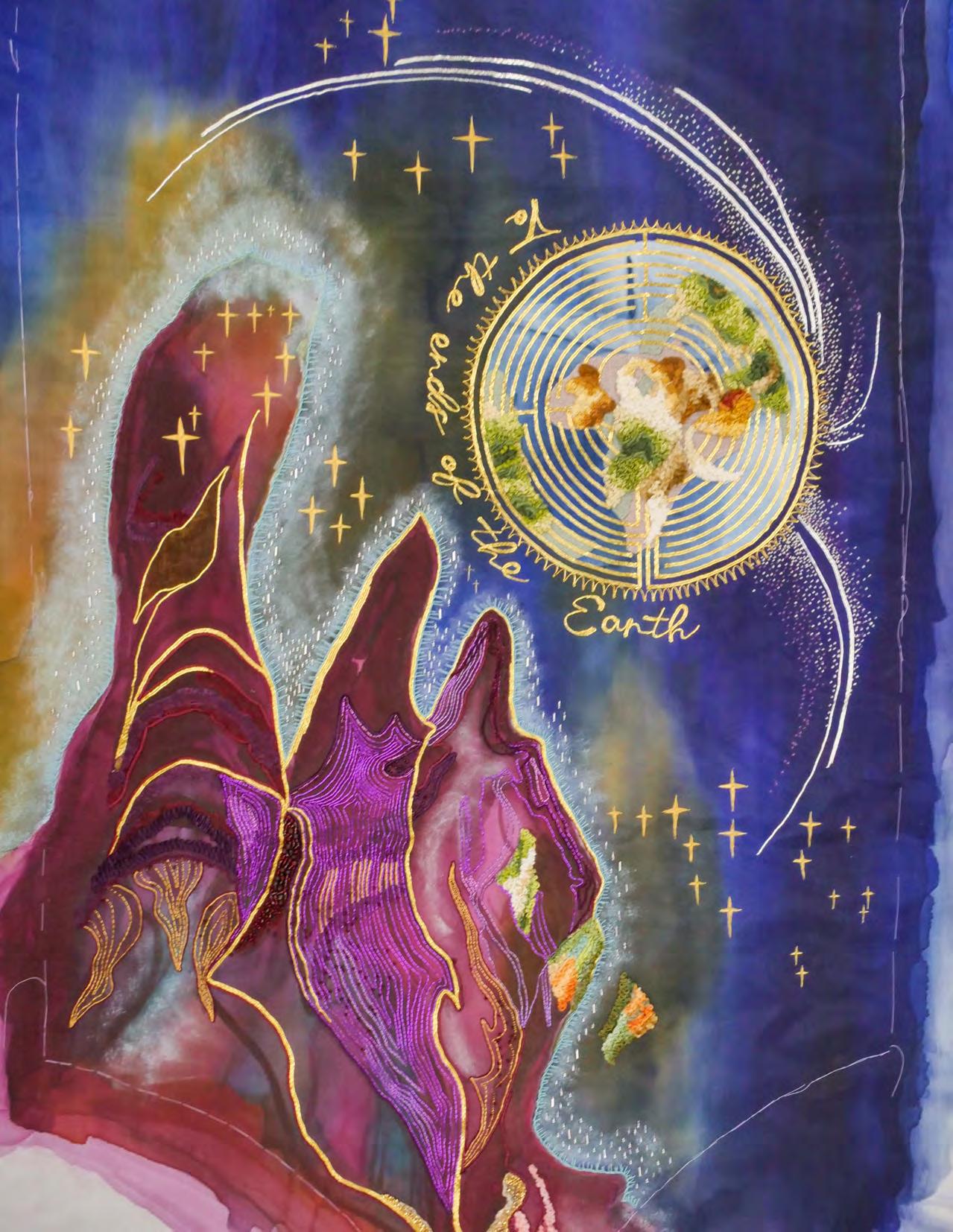
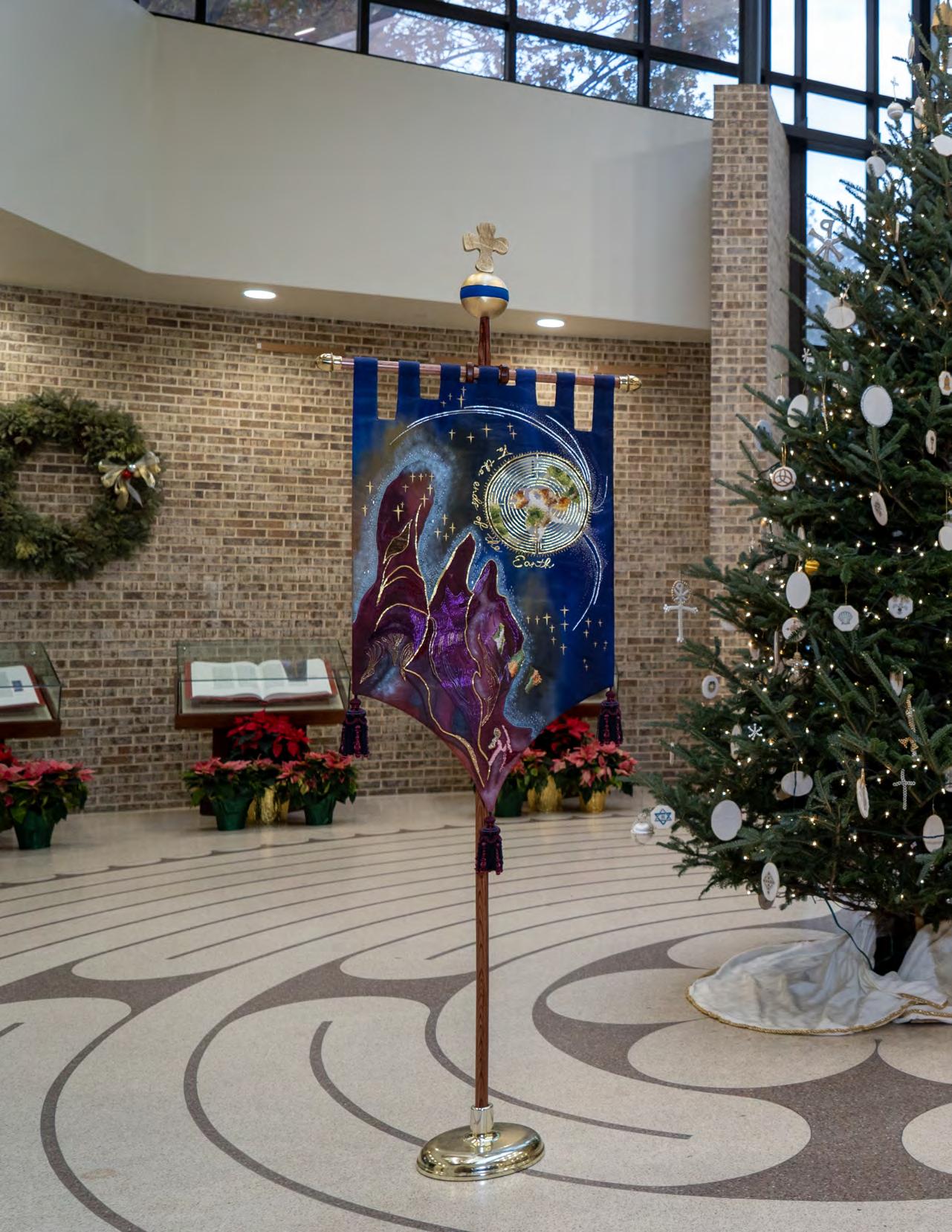



by Delynda Moravec
In July 2024, eight youth pilgrims, Father Casey, and I embarked on a pilgrimage to Scotland. Scotland is a land steeped in history and mysticism, and our pilgrimage became more than just a destination. It was a living classroom of wonder, where every stone, mountain, and loch held a story that invited reflection and connection. Scotland’s natural beauty evokes a sense of the divine, offering a reminder of God’s ever-present majesty. The physical act of hiking in these sacred spaces paralleled our spiritual journey. The sweeping vistas of places like Glencoe invited quiet contemplation, a pause from the noise of modern life. For each of us, accustomed to fast-paced, technology-filled days, this stillness often sparked a newfound appreciation for creation and our place within it.
The historical and spiritual sites of Scotland add another layer of meaning. From the ancient stones of Iona Abbey to the towering presence of St. Giles’ Cathedral in Edinburgh, these landmarks carry the weight of centuries of faith and devotion. When we visited Iona, often called the “cradle of Christianity” in Scotland, we felt a palpable connection to the roots of our faith. Walking the same paths as St. Columba and countless pilgrims before us reminded us of our shared beliefs and heritage across time.
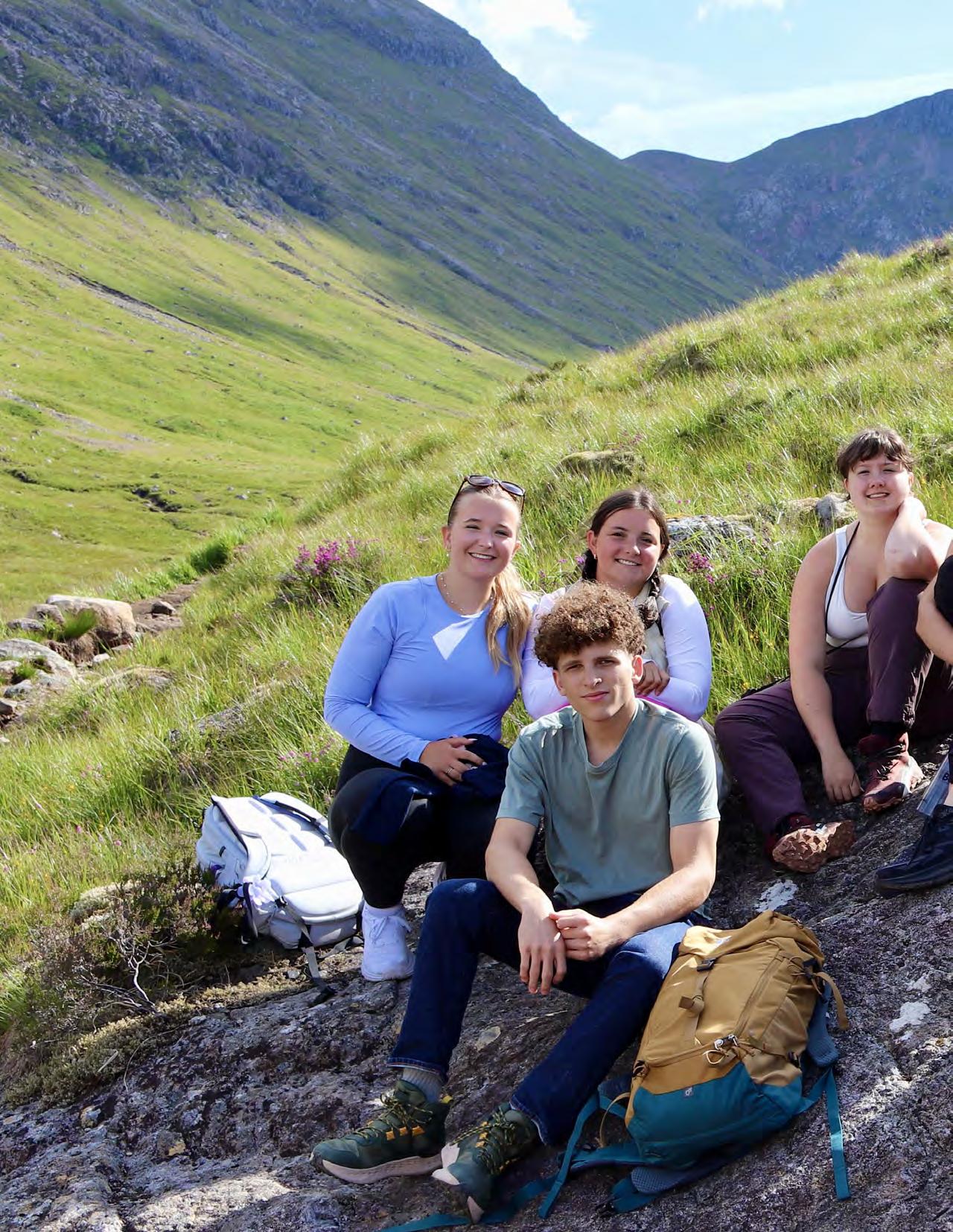

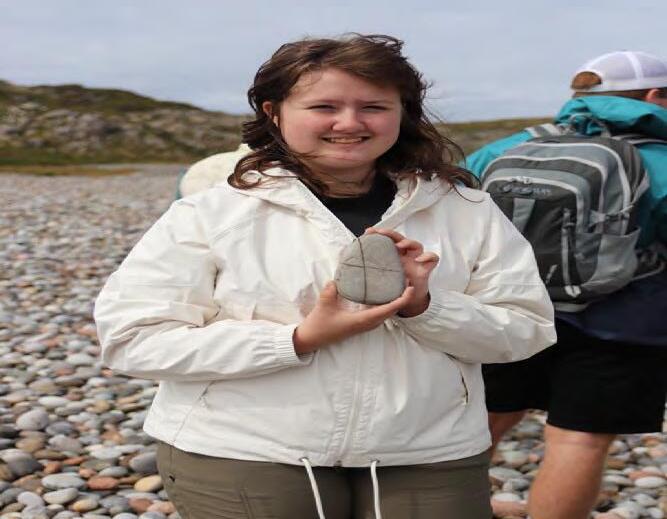

Our pilgrimage fostered a strong sense of community among our group. Shared experiences—whether it was a challenging hike to St. Columba’s Bay, preparing meals together in a comically limited kitchen, or simply watching the sunset on Iona— created bonds that transcended individual differences. This sense of togetherness mirrors the broader Christian call to unity and love. In these moments, we discovered new dimensions of our faith and felt it come alive in fellowship with one another. The wonder we experienced in Scotland was enhanced by the deepening of our relationships.
Scotland’s blend of ancient spirituality and modern culture resonated with each of us. We observed how tradition and innovation coexist, and how faith can be integrated into contemporary life, even in a country where religion is on the decline. The oral and written storytelling traditions encouraged us to reflect on our own narratives—considering where we have been, where we are now, and where we may encounter God along our journey.
The wonder of Scotland encompasses more than its scenic beauty; it is a space where faith, history, and community converge. Our pilgrimage was transformative, allowing us to see God’s hand in both the world and within ourselves. The journey is not merely to a destination, but to a deeper understanding of the Creator and creation. As we left Scotland, we carried that wonder with us, not just as a memory to cherish, but as a spark to ignite our ongoing spiritual journey.
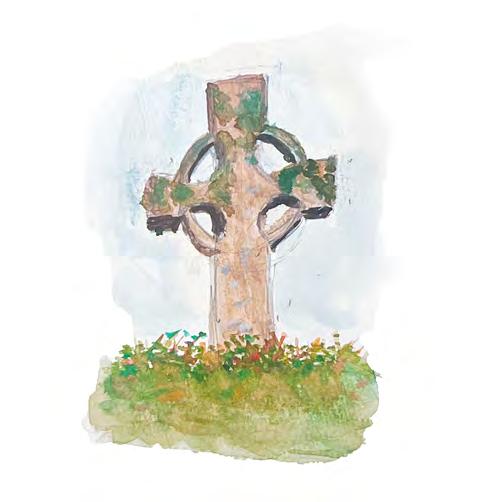

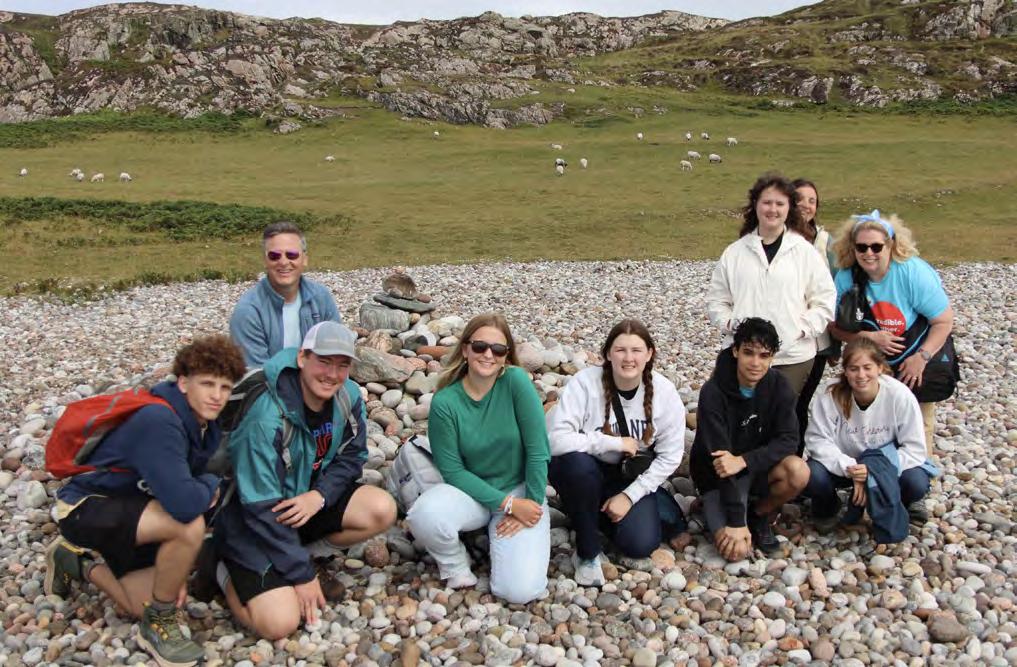
by Kerry Tate
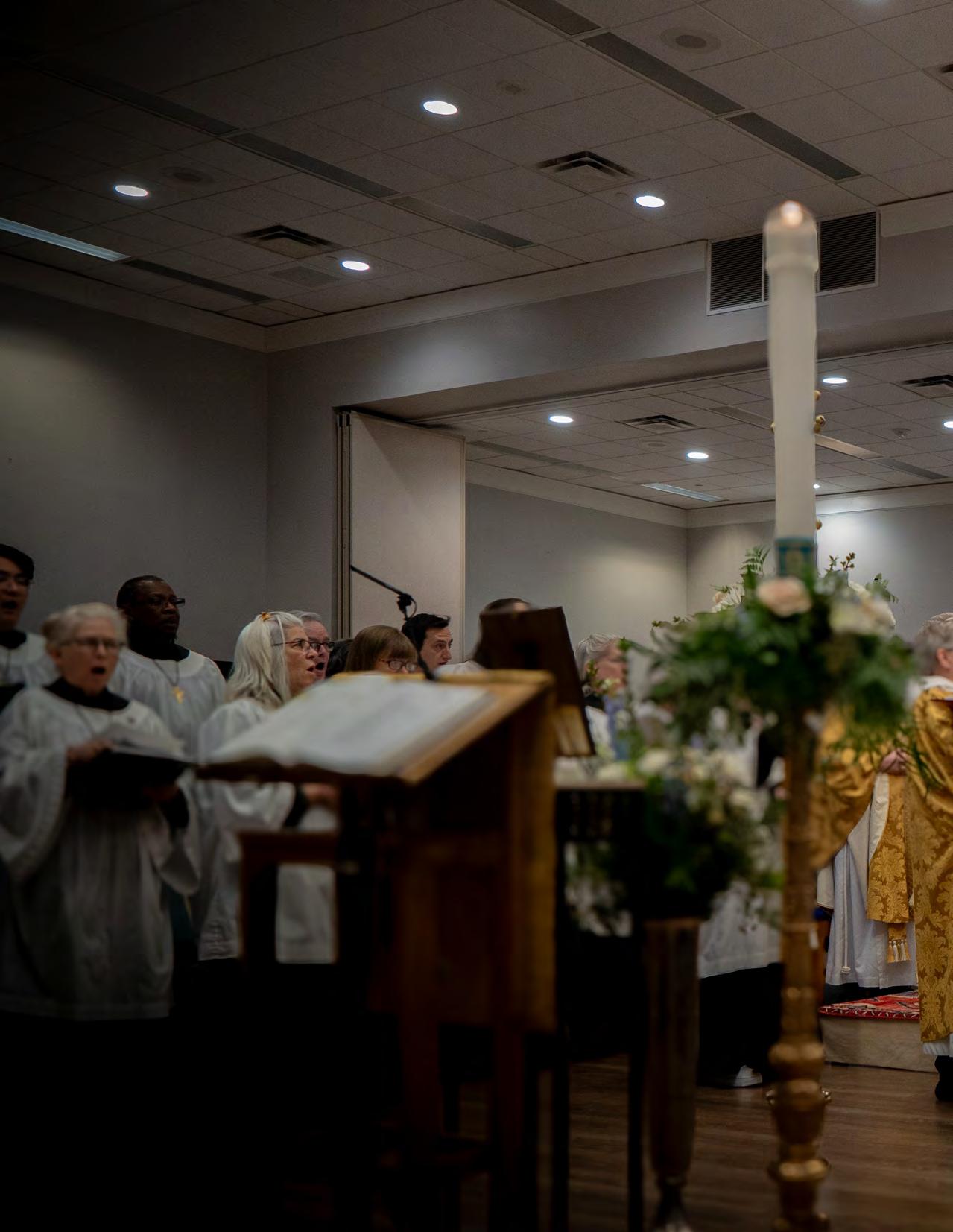

Growing up deaf in a loving Christian family was like trying to decode a complex symphony through silent sheet music. My family did their best to communicate the essence of Christianity, but my prayers often went something like, “Dear God, why do I have to close my eyes? I can’t see you or read your lips!” As a prolific lip-reader, I saw more of what was happening behind the pulpit than in the front row.
My first eight years were spent in the Baptist church, where the preacher’s assurances that Jesus would walk through the door at 12 a.m. or 9 p.m. seemed as abstract to me as trying to catch a shadow in a dark room. Much less, the idea of Jesus knowing our prayers felt distant in a world where I couldn’t hear the melody of faith.
As a child, I watched with bewilderment as everyone closed their eyes during prayers. To me, it seemed like a strange game of hide-and-seek with God. I often stood with my eyes tightly shut, only to be nudged by my brother when everyone sat down after saying “amen.” I felt like a misplaced actor on stage, trying to lip-read the dialogue of a play where I was both in the audience and the cast.
Then came the change. My best friend’s father was an Episcopal priest, and instead of the usual Sunday school, we had “sundae school” on Wednesday afternoons—ice cream and lessons combined. It was a delightful twist on religious education that I eagerly embraced.
Amid the conflict within the Baptist church over our preacher’s previous marriage—an issue that still baffles me (honestly, who cares if he was married before?)—the disagreement reached a fever pitch with a so-called “prayer meeting,” where factions of the congregation shouted at each other across the
church. As an 8-year-old, I found this spectacle both horrifying and bewildering. My parents, equally uncomfortable, seemed ready to vanish under the pews. It felt like a bad soap opera, only with less singing and more shouting.
When I began attending the Episcopal church, it was like stepping into a warm hug after a very chilly and contentious debate. The contrast was striking— here, people genuinely liked each other and weren’t yelling across the aisles. At just 8 years old, I proudly declared to my family that I loved the Episcopal church because it was a place of true love and harmony, free from the bickering I’d seen elsewhere. My parents were so surprised by my perceptiveness that they wondered if I’d missed my calling as a church dynamic consultant. Eventually, they made the brave yet peaceful decision to leave the Baptist church and embrace the love and acceptance we had found.
In contrast, I found solace in the Episcopal tradition. Fathers Miner and Acuff were real lifesavers during church services. They even recruited me as an acolyte to use me to help out when a crisis struck, like needing someone to fetch something from the sacristy. My lipreading skills turned out to be a secret superpower, letting me catch every word during the service—even when things got hectic. It was like having an inside scoop on all the divine drama!
On a serious note, Father Miner told me that prayers were more about praising God, sharing our secrets, and working through our needs than closing our eyes. This revelation was a turning point, showing me that prayers could transcend the physical act and connect directly with the divine.
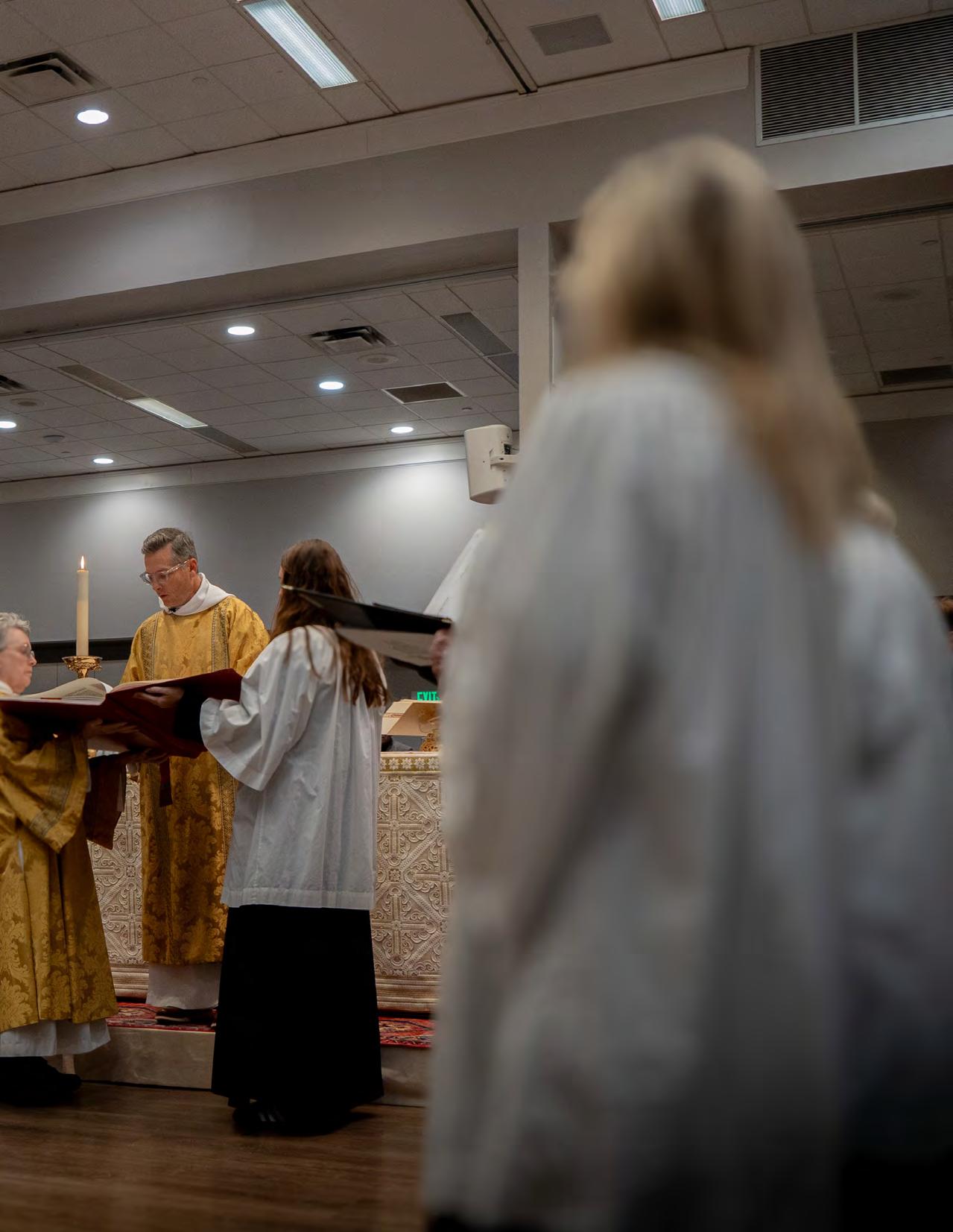
As we move forward, many years have passed since those formative experiences. They have shaped my understanding of faith and community in profound ways. It took many years for me to understand the essence of prayer truly. In my silent realm, I discovered that my conversations with God were not bound by the spoken word. I shared my prayers through the language of the heart—a direct connection that didn’t need translation. I realized that my silent dialogue with God was just as meaningful as the verbal prayers I witnessed around me. It was like finding out you don’t need to understand the lyrics to enjoy the music.
In retrospect, I see the humor in my early attempts to fit into a world of sound that I could only observe from the sidelines. I felt a little like a misplaced actor trying to join in on a play where I couldn’t hear the dialogue. Yet, those moments of confusion led me to a deeper, more personal understanding of faith. My silent prayers were a direct, unfiltered exchange with the divine, untroubled by language barriers or misunderstandings. It turns out that God’s message is pretty clear, no matter how you hear it.
In today’s world, where divisions and animosity often dominate, Jesus calls us to engage with others differently. True liberation comes from extending freedom and compassion. It’s not the surrounding darkness that is most daunting but the fear of the unknown, even when light is present. Our challenge is to move beyond observing faults in others and to listen and empathize truly.
Rather than focusing on criticisms, Jesus teaches us to cultivate a deeper awareness and appreciation for our prayers. By taking and embodying the love and acceptance exemplified in God's miracles, we align with God's teachings and contribute to a more harmonious world. The true essence of faith and communication transcends the limitations of our senses and speaks directly to the heart, whether through sound or silence.

by David Flick
When the Rev. Robin Razzino told her parishioners at the Episcopal Church of St. Clement in Alexandria, Virginia, that acquiring a new organ for their small congregation was “life-altering,” she assured them she was not speaking lightly.
“You might think that is a hyperbolic statement,” she said in a sermon, “but stick with me. This is a life-changing moment for our church — and for each of you.”
That organ is one that parishioners at Transfiguration have known and loved for over 50 years, including the last 16 years in the south transept. After a half-century of service, first as Transfiguration’s primary instrument and later as an auxiliary organ accompanying years of funerals and weekday services, the organ, officially known as Aeolian-Skinner Opus 1525, but affectionately known as “Howard,” has found a new home 1,100 miles from the corner of Hillcrest and Spring Valley.
The instrument was designed by Robert L. Sipe, a Dallas organ builder, and built in Boston. It made its debut at Transfiguration at Christmas in 1971, barely a year after the Nave had been opened. In those days, Transfiguration was on the farthest edge of Dallas, but the organ quickly received the attention of local musicians. In 1972, the organ was used for recitals at the American Guild of Organists national convention, followed by a symposium sponsored by Southern Methodist University. Over the years, the instrument has powered recitals by such prominent organists as Luigi Tagliavini, Anton Heiller, and Marie-Claire Alain.
In 2009, the Ross Organ was replaced in the gallery by a larger instrument, Richards, Fowkes & Co.’s Opus 17, later named for the church’s third rector, the Rev. Jerry D. Godwin. Before renovations to the gallery for the new organ could take place, the Skinner/Sipe organ was relocated to the south transept, where it continued to
be played. The hope was that one day it would grace a chapel on the campus. In 2013, the Vestry dedicated the instrument to the memory of Howard Eddins Ross, who served for 39 years as the church’s first music director –thus, the moniker of “Howard.”
By 2020, it became clear to church leaders that any future chapel would not have room for an organ as significant as the Ross Organ. Furthermore, plans to convert the south transept into a side chapel would require the organ’s relocation to a new home. But where?
Transfiguration’s Rector, the Rev. Casey Shobe, and Director of Music Joel Martinson initially hoped the organ could remain in the Dallas area. Numerous prospective locations were explored, including several where the organ would be given as a long-term loan. None of those plans materialized, so the search radius was expanded. “Howard” was listed on the Organ Clearing House, a well-respected listing site for available instruments, and information was also posted on the church’s website.
Lauding the organ’s availability at no cost to a good home Fr. Casey shared that link with his network of clergy colleagues around the country. Mtr. Robin saw his posting – she and Fr. Casey were classmates at Virginia Theological Seminary – and she wasted no time contacting him. Her parish needed a new organ — badly.
“When I came here eight years ago, I knew even then we needed a new organ,” she said. “An organ is important, so we have used the one we have, but it’s a terrible organ.”
She said the congregation is blessed with a music director who has nursed the instrument along, but if that director ever left, there is no way St. Clement could lure a new music director with such an antiquated instrument.
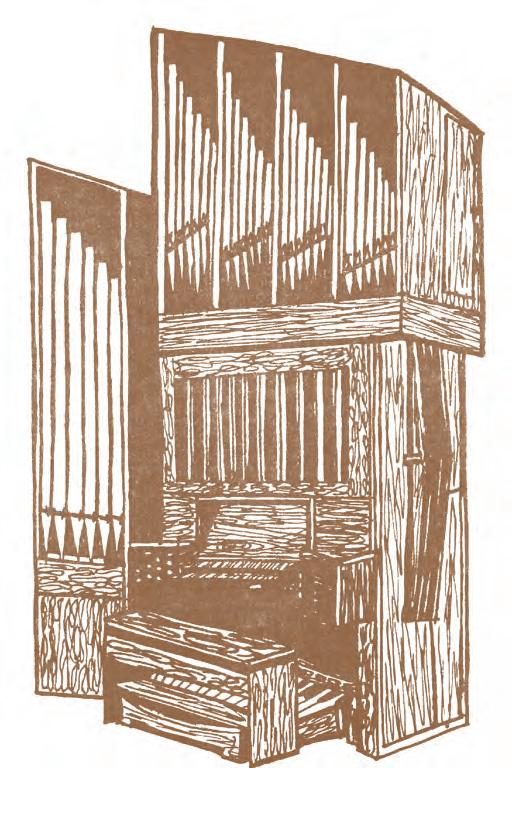
Aeolian-Skinner Opus 1525
Dedicated to the memory of Howard Eddins Ross
Although Mtr. Robin was unfamiliar with the Ross Organ, her music director assured her that the builder had a sound reputation. A friend, who was also a local organ builder and former parishioner, Michael Hart, volunteered to fly to Dallas to check it out. His report was enthusiastic. Mtr. Robin decided to try to acquire the organ.
But to do so, she said, the parish needed to come up with more than $50,000 to pay to ship and reassemble the instrument. St. Clement is a small parish, with about 55 attendees each Sunday, and the Vestry had only recently installed a new air-conditioning system. Appealing to the Vestry and the congregation, she told them that no less than the future of the parish was at stake. And they responded.
Within two weeks, they raised nearly the whole sum. Mr. Hart came from Virginia in October and led the painstaking disassembly process over an entire week. Mr. Martinson and members of Transfiguration’s music ministry also assisted and provided “Howard” with the honor it deserved after so many years of beautiful music.
Today, the Ross Organ resides at St. Clement, a perfect fit for the space. It awaits assembly and will once again be playable in January. Mtr. Robin is thrilled. “It looks so good, and it fits so well; it’s really going to enhance the beauty of our space,” she said.
Joel Martinson said the Ross Organ has indeed found a good home. “It was small, but it served us very well for years,” he said. “And it’s going to be great for them. It will allow strong Episcopal music to flourish at that church.”
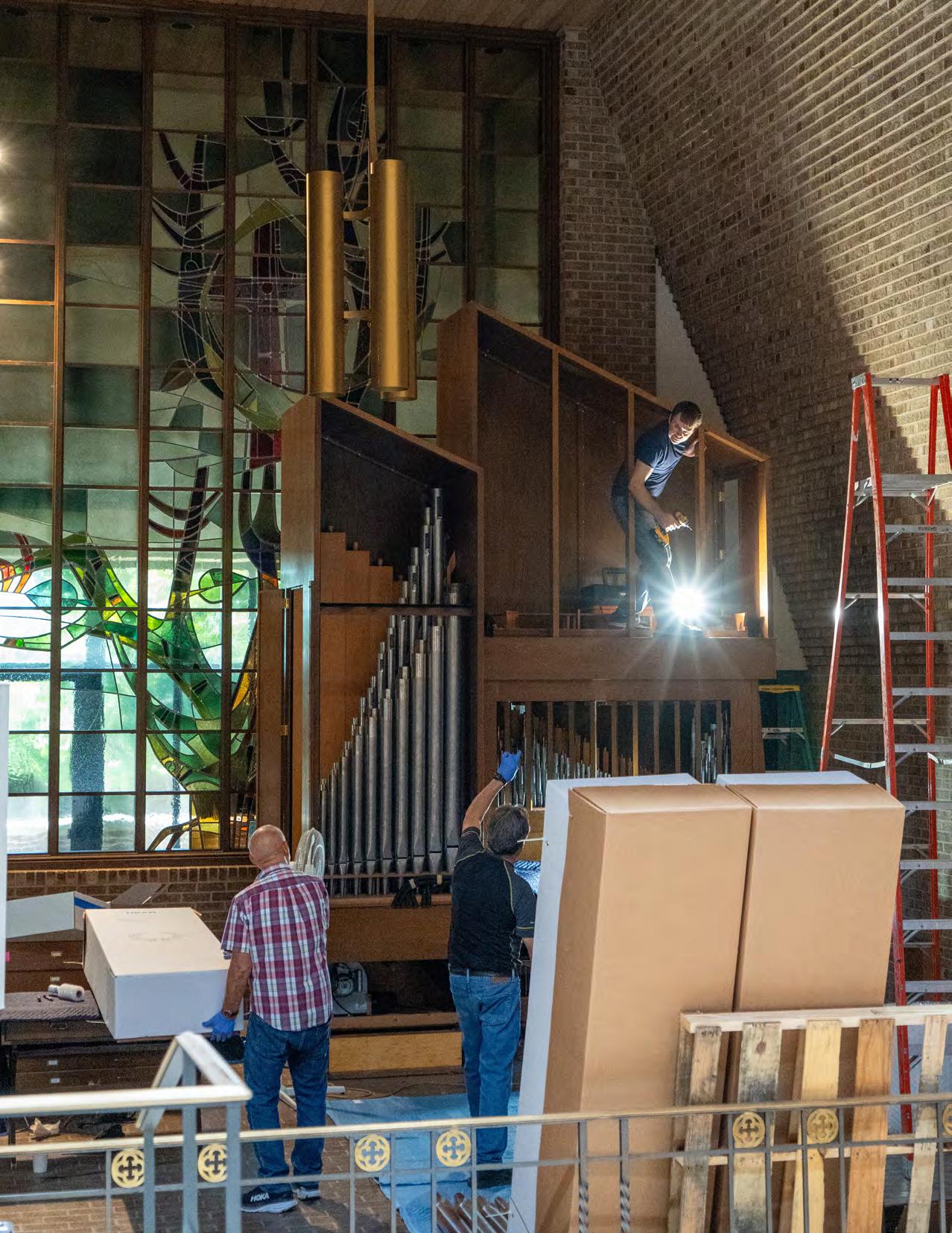

by Alyson Thompson
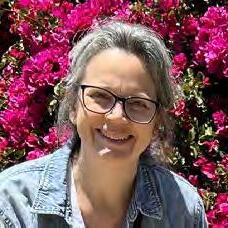
On November 5, I worked as an election clerk at Richland College—I know of friends from Transfiguration who did the same in other locations.
I was working with a group of election officials that had been at this location throughout early voting, so they really are a devoted bunch—the judge is a Democrat and the assistant judge a Republican (they verified that I was a Democrat because they need a certain proportion of each party for their team).
I was stationed at the vote tabulator, where I served all day, except for a brief lunch break.
It gave me joy to greet each person with a smile, look them in the eyes, and tell them how to place their ballot in the tabulator, that their ballot was scanned and counted, that the little number “public count” had increased by one because they voted, and to thank each of them for voting.
They were, to a person, very satisfied that they had voted, many of them really excited about it—one woman prayed over her ballot before she placed it, and I joined her in the Amen. I had the privilege of meeting over 900 people that day.
The majority were people of color, many who did not have English or Spanish or Vietnamese as a first language, some who brought little children, some with wheelchairs or walkers or canes who took great personal effort to come in and vote.
I imagine that there were many who voted for Harris and many who voted for Trump—and I had no idea who was who, and it did not matter because I got to greet all of them after they had done something that they were pleased to do.
When it was all over, and I was finished with my duties at about 9 pm, I said thanks to the judge and assistant judge for letting me be part of the team, and I got a big hug from the Republican assistant judge, who was so appreciative of the help.
So, when I think about this election, even though I was personally disappointed in the outcome, I remember being able to greet each of those voters and thank them for coming to vote. I will also not forget the judge and assistant judge working so well together and my hug from my fellow election judge. That experience as an election clerk will remain my touchstone for the 2024 election.
Here are some recommended books from our clergy, friends, and family. The selected books were reviewed and chosen for the Christmas and Epiphany season.
by Charles Marsh
Recommended by Fr. Casey Shobe
A cinematic adaptation of the life of Dietrich Bonhoeffer was released this fall, bringing the theologian, pastor, and martyr into the spotlight. However, scholars of the saint’s life have noted the movie’s numerous inaccuracies and the way it flattens a complicated Christian into a typical Hollywood cardboard cutout. If you’d like to learn about the real Bonhoeffer, I highly recommend the biography Strange Glory by Charles Marsh (Knopf, 2014). An historian at the University of Virginia, Marsh displays a scholar’s commitment to truth with a compelling writing style. For those worried about the rise of nationalism and authoritarianism in our time, the actual Bonhoeffer is a saint we should listen to.
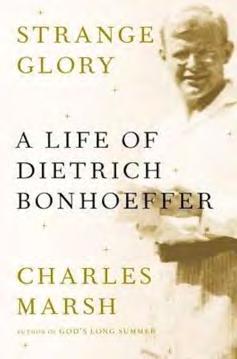

The Alchemist by Paulo Coelho
Recommended by Mtr. Rebecca Tankersley
Years ago while working my way through Brené Brown’s books on authenticity and whole-hearted living, I came across a reference to The Alchemist , a book Brené says she reads regularly. As soon as the audiobook came available through Libby, I gave it a listen. This beautifullywritten tale of self-discovery, follows Santiago, a young shepherd, on his quest to find treasure and live his best life. Through a compelling story, rich with symbolism, Coelho explores themes of dreams, calling, and spiritual awakening, reminding us of the many ways God gently guides us toward our true purpose.
The False White Gospel by Jim Wallis
Recommended by Fr. Terence Roper
I heartily recommend The False White Gospel (St Martin's Essentials, 2024), which has also been recommended by former Presiding Bishop Michael Curry with these words: “Read this book...and be part of the desperately needed change.” Jim Wallis is the inaugural holder of Georgetown University's Archbishop Desmond Tutu Chair in Faith and Justice, and was on President Obama's first White House Advisory Council on Faith-based and Neighborhood Partnerships. His concern in this new book is the rise of Christian Nationalism as a false gospel – an attractive but dangerous heresy.
by James McBride
Recommended by Fr. Ted Clarkson
This fall, as I walked along the greenbelts in Carrollton, where I live, I enjoyed listening to The Heaven and Earth Grocery Store by James McBride (Riverhead Books,2023). This wonderful novel explores the profound challenges faced by Jewish, African American, and disabled communities in mid-20th-century America. Set in the crumbling neighborhood of Chicken Hill, it centers on a diverse group of people who find solace and support at a local grocery store. Through its rich characters and masterful storytelling, McBride highlights the struggles of racism and exclusion, while also celebrating the resilience, goodness, and deep human connection that emerge in the face of adversity.
by Bruce G. Epperley
Recommended by Ed DeStefano
I love this collection of Christmas meditations (Anamchara Books, 2022), with each including a Scripture passage and a reflection on the life of Francis or Clare. In the introduction, the author describes his inspiration: “I was in search of a spiritual focus that would enable me to immerse myself in the Christmas season long after the presents have been unwrapped and the tree taken down.” Each chapter concludes with a prayer asking for the Spirit’s guidance to apply the Spirit of Christmas to our life today.
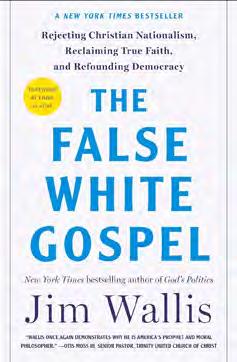

by Christopher Bryan
Recommended by Fr. Michael Merriman
My church background growing up was thoroughly Protestant and as such, suspicious of devotion to the mother of Jesus. Some of that lingers, though years of “high Church Episcopalianism” has made me much more comfortable with devotion to the Blessed Mother. Then, through the recommendation of a friend, I read Mary of Nazareth (Seabury Books, 2024). In a thorough, but not overly academic, style, he sorts out history from legend, the “real” Mary from the one portrayed by popular piety. Even drawing only on the New Testament, there’s a lot we can say about her. This book opened for me a much greater appreciation for the mother of our Lord, and it will no doubt do the same for you.

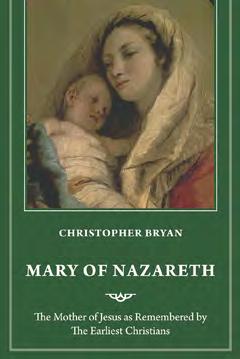

by the Rev. Ted Clarkson
For many of us, the Great Vigil of Easter is the end of a short, spiritual journey that begins on the previous Ash Wednesday, when we promise to keep a holy Lent through various spiritual disciplines. It is a journey that we make year after year with familiar milestones and pathways. But for one member of our congregation, the Great Vigil of 2024 marked the end of a much longer journey, one of faith, courage, and great personal sacrifice.
Behnam Maroufian was born in Tehran, Iran, and raised in a devout Muslim family, but he was drawn to Christianity at an early age. He had an older cousin who studied abroad and married a woman from England. One day, when Behnam was seven or eight years old, the couple visited Tehran. Behnam remembers how she wore a gold cross around her neck and told him about her Christian faith. She made a remarkable impression on him and gave him a curiosity about Christianity that has never faded.
However, nurturing his fledgling faith proved to be difficult and dangerous. Muslims are outlawed from converting to Christianity in Iran, and whenever he shared his curiosity with others, he was told to be quiet and keep his thoughts to himself. Churches turned him away for fear of running afoul of the authorities; bookstores would not sell him a Holy Bible in Farsi. Yet his desire to become a Christian did not wane. As a young adult, he traveled to Armenia several times and worshipped with the Orthodox community there, but they were unwilling to baptize him. For years he lived as a Christian, but without a Christian community to receive and support him.
Behnam later decided to come to the United States to continue his education; he received a student visa, enrolled at Dallas College (Brookhaven Campus), and moved to Texas. When he arrived, the first thing he did was look for a church. He tried to find a community
that reminded him of the Armenian Orthodox Church he visited so often. Instead, he found small congregations in non-descript strip malls without any of the art and liturgy he fell in love with or congregations worshipping in languages he could not speak.
On Saturday, November 4, 2023, Behnam prayed desperately for God to lead him to a church where he might find a spiritual home. This time, when he looked for churches near him on Google Maps, Transfiguration popped up. He was so excited and rushed out the door to make our 5:30 service. Sadly, the service had ended when he arrived, but I invited him to return the following morning. He returned on Sunday and has been with us almost every Sunday since.
A few weeks after he arrived, Behnam expressed his desire to be baptized, and for the first time, he received the answer that he longed for: Yes. He joined “The Way” and was enrolled as a Candidate for Holy Baptism the following Lent. However, his choice to become a Christian came with strings attached. It meant that going home would be dangerous for him and his family. To protect those he loves, he has had to hide his conversion from them. It’s a sacrifice that few of us are ever asked to make, one that can only be made by those who truly know the love of Jesus.
At last year’s Easter Vigil, after decades of curiosity and courage, Behnam was baptized into Christ’s one, holy, catholic, and apostolic church, bringing his long journey to Christianity to an end. But of course, baptism is more of a beginning than an ending. It’s the beginning of a lifetime of grace and service. He will need all that grace for the years ahead as he looks to stay in this country, which will allow him to practice his faith.
These days, you will find him sitting in the pews or working the sound desk. You’ll also likely run into him if you come to our Wednesday service. We are a richer place now that Behnam is part of our parish family, a fellow traveler on this journey of Christian discipleship.
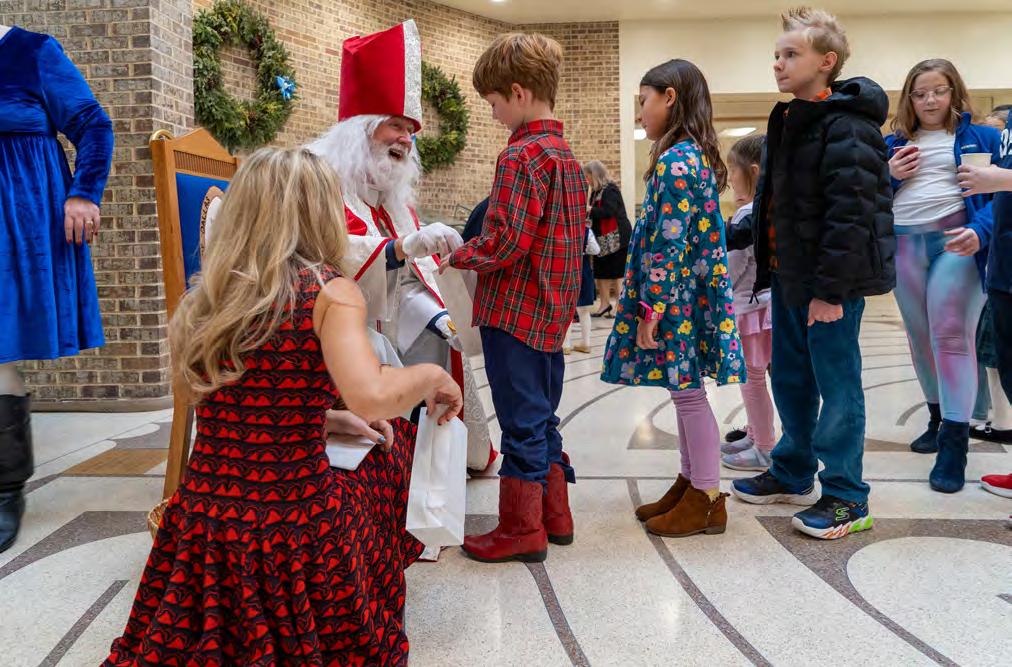
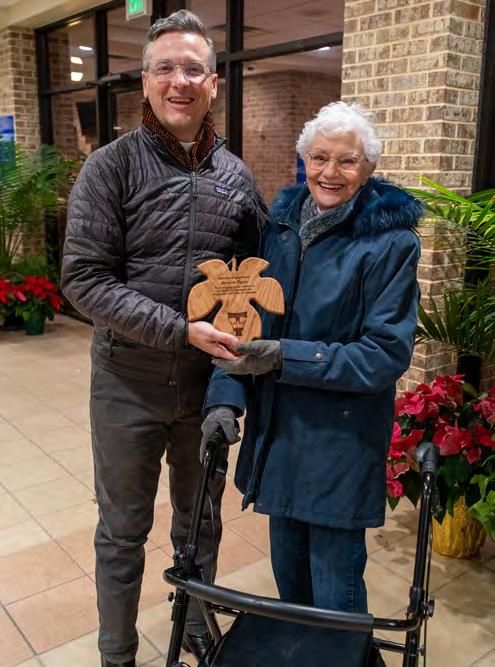
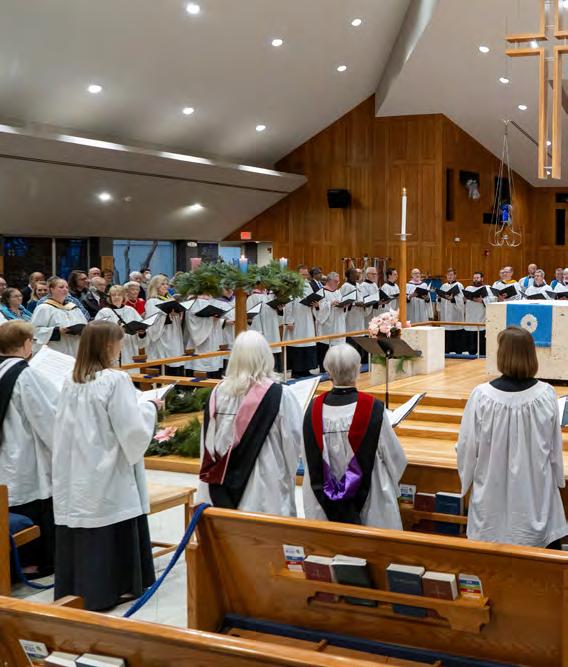
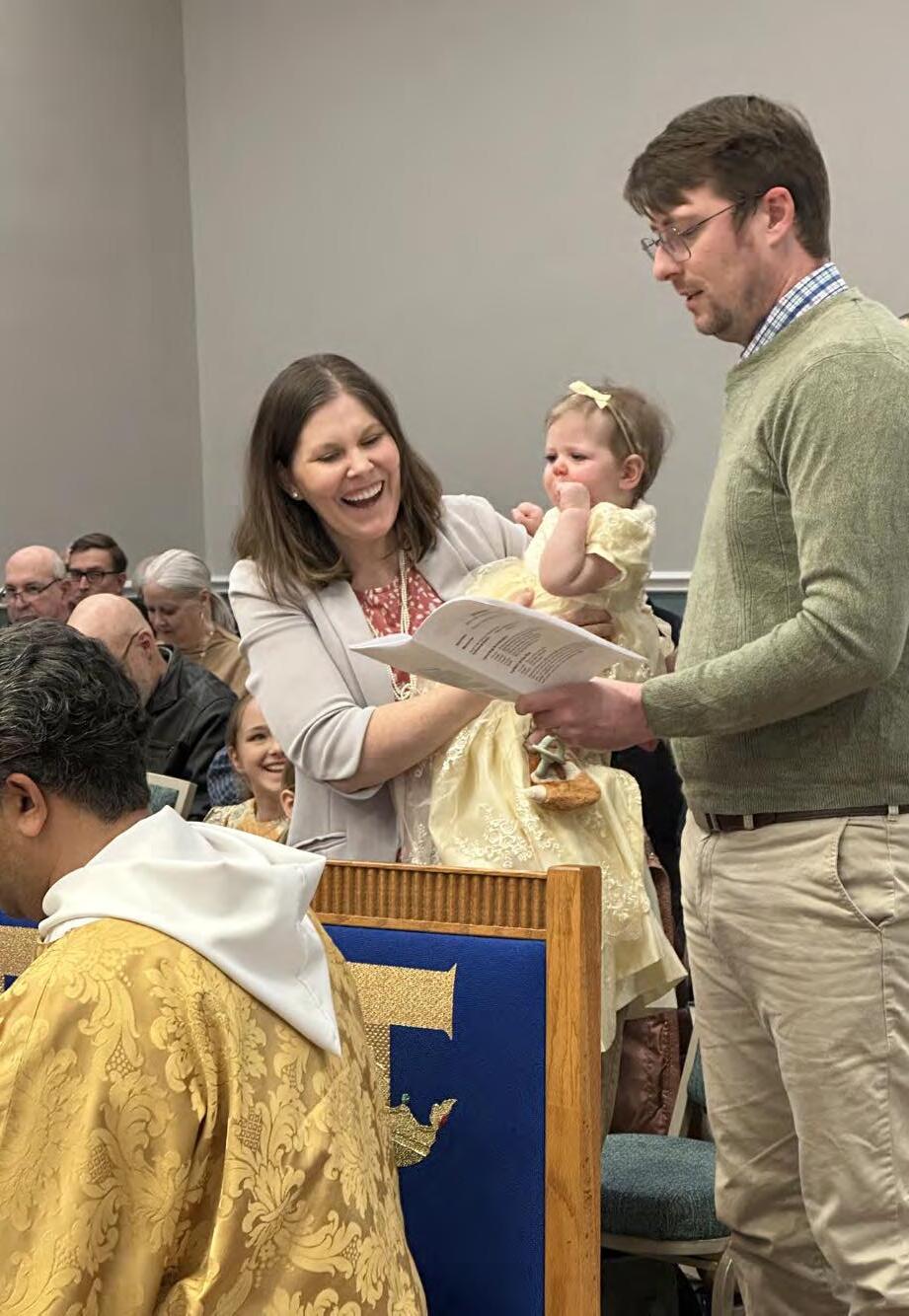

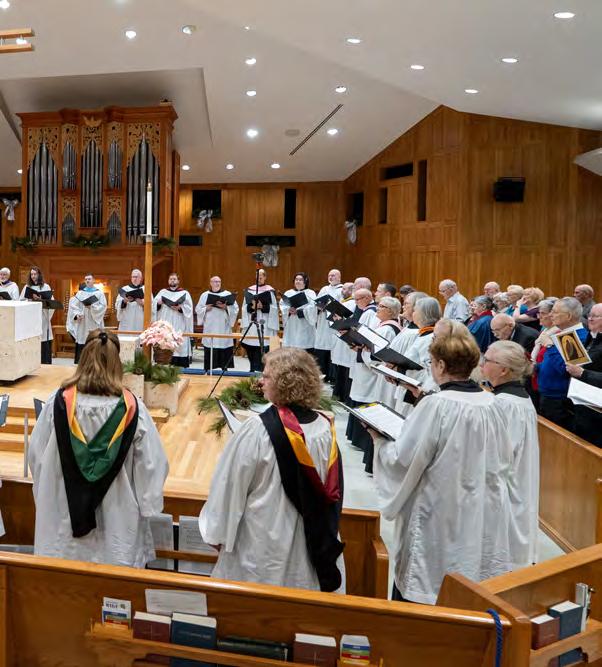
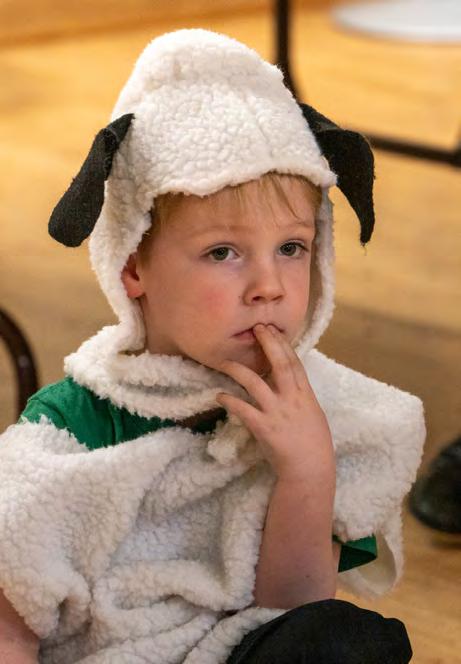

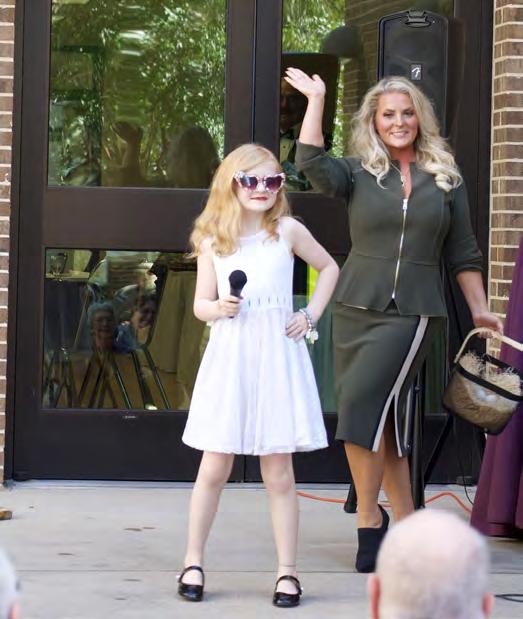
Illumine is a quarterly publication of Church of the Transfiguration. The word itself has two meanings: to light up or brighten and to enlighten (someone) spiritually or intellectually. The goal behind this magazine is to tell the stories of this congregation, highlight new ministries, and celebrate where God is at work in our midst.
CLERGY
The Rev. R. Casey Shobe, D.Min. Rector
The Rev. Rebecca Tankersley Senior Associate Rector
The Rev. Ted Clarkson Associate Rector
The Rev. JoNell Lindh Pastoral Assistant
The Rev. Terence C. Roper Rector Emeritus
PROGRAMS
Allison Blalock Director of Children’s Ministries
Delynda Moravec Director of Youth Ministries
Gabby Guion Minister for Congregational Life
TJ McCoy Director of Communications
Al Blackwell Digital Communications Specialist
WORSHIP SERVICES
Wednesday | 6:00 p.m.
Thursday | 12:00 p.m.
Saturday | 5:30 p.m.
Sunday | 9:00 a.m. and 11:15 a.m.
MUSIC
Joel Martinson
Director of Music and Organist
Chris Ahrens
Director of Youth Choir
Kimberley Ahrens
Director of Children’s Choirs
David Stanley
The Table Music Director
ADMINISTRATION
Cathleen Dolt
Parish Administrator
Shalu Abraham
Executive Assistant to the Rector
Darla Rupert
Bookkeeper
Fred Ellis
Administrative Assistant
OPERATIONS
Bracken Reece
Director of Operations
Alex Alvarado
Sexton
Erik Welch
Sexton
Mat Thekkil, Senior Warden
Mike Mignardi, Junior Warden
Chip Brownlee
Michael Durrance
Brian Ferrell
Lindsey Murphy
Olga Ruff
Elaine Sweet
Jeremy Teeple
Alyson Thompson
Brett Vanderbrook
Peter Young
Jay Madrid, Chancellor
Evan Williams, Assistant Chancellor
Bill Evans, Treasurer
Libby Nicodemus, Clerk
1. Cover : Cecelia Carmona in Children's Christmas
Pageant | Photo by John Makowski
2. Children's Christmas Pageant Procession
Photo by Robert Hacker
3. Mike and Susan Shobe, holding newly baptized Casey, along with Fr. Joe di Paola ( A Christmas Carol illustration by F.S. Coburn, 1900)
4. Detail of hand embroidery work in progress
Photo by Watts and Co
5. Detail of hand-painted “Pillars of Creation”
Photo by Watts and Co
6. Banners hanging in Labyrinth | Photo by TJ McCoy
7. Columnar basalt rising from the sea at Isle of Staffa
Photo by Casey Shobe
8. Youth Pilgrims: Libby Cone, Evan McCoy, Naomi Dick, Lilly Myers, Sarah Robb, Maisie Harms, Nathaniel Dick, Owen Jackson in Glen Coe, Scotland
Photo by Casey Shobe
9. Lilly Myers on the Isle of Iona | Photo by Delynda Moravec
10. Evan McCoy in the ruins of a convent on the Isle of Iona
Photo by Casey Shobe | Cross by Evan McCoy
11. Youth with Delynda Moravec at St Conan's Kirk, Loch Awe, Scotland | Photo by Casey Shobe
12. Youth with Fr. Casey and Delynda Moravec at St. Columba's Bay on the Isle of Iona
13. Liz Kerner, Fr. Casey, and Maisie Harms process the Gospel in Roper Hall | Photo by TJ McCoy
14. Howard Ross with the Aeolian-Skinner Opus 1525 in the Choir Gallery (1971)
15. Disassembly of the Ross Organ | Photo by TJ McCoy
16. Benham Maroufian | Photo by TJ McCoy
17. Visit from St Nicholas | Photo by TJ McCoy
18. Quinn Scott Carter being presented for Baptism
Photo by Gabby Guion
19. Newly baptized Ezra James Andrew Fierbaugh
Photo by Robert Hacker
20. Fr. Casey and Ellen Dingwall Award recipient, Maggie Sharer | Photo by TJ McCoy
21. Advent Lessons & Carols at Church of the Ascension
Photo by TJ McCoy
22. Children's Pageant participant Matthew Fones
Photo by John Makowski
23. Harpist Rachel Lamb Mazzucco | Photo by TJ McCoy
24. Adelaide and Courtney Barrow at St. Hilda's Fashion Show
Photo by TJ McCoy
Back Cover: Naori Choi with The Saint John's Bible
Photo by Robert Hacker
